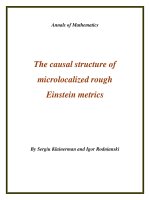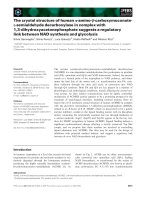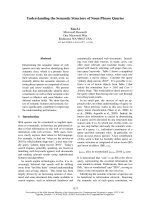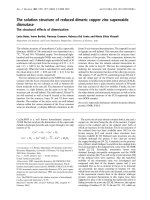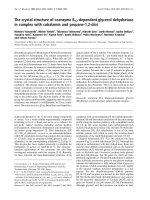The sound structure of english
Bạn đang xem bản rút gọn của tài liệu. Xem và tải ngay bản đầy đủ của tài liệu tại đây (77.95 KB, 8 trang )
1
The Sound Structure of English: An Introduction
/D@ saUnd strVkÍ@ @v INglIS/
Chris McCully
The Website
[Various people have worked on this website, and that help ought to be publicly
acknowledged: Wander Lowie (Rijksuniversiteit, Groningen) helped me put the
pages up on the web. Monika Schmid (Rijksuniversiteit, Groningen) acted as a
reader over my shoulder. To both – thank you.]
Welcome to the web pages which accompany
the hard text of The Sound Structure of
English: an Introduction (CUP, 2008). Here
you’ll find…
•
Further commentary on the in-chapter exercises
•
Suggested solutions to the end-of-chapter exercises
•
Links to sound-files and other materials and sites
A note on phonetic fonts
The IPA symbols on this site should display correctly in your browser. If they do not,
please click on the following link:
/>This will take you to a site (UCL) from which you can download the IPA in a number
of different styles (Doulos, Sophia etc.). The downloads are free.
*
2
CHAPTER 1: INTRODUCTION
COMMENT ON IN-CHAPTER EXERCISES
1.1, PAGE 2: can you construct other, possibly unusual, combinations of letters
which ‘spell’ English words, eg. <ghoti> = ‘fish’, <aughturnun> = ‘afternoon’
(<aught> from <draught>, <ur> from <auburn>, <un> from <lun-atic>)?
Some specimen words might be <ghread>, ‘Fred’ (<gh> from <enough>, <ea>
from
<chroo>, ‘shrew’ (<ch> from <louche>, <oo> from <moon>.
1.2, PAGE 4: how many other pairs of homophones can you find in your own
variety of spoken English?
Some examples from my own variety of English are
buy
+
by
feet
+
feat
know +
no
guest +
guessed
You will be able to find many others in your own variety!
1.3, PAGE 6: by observing your own variety of spoken English, how much data
could you amass to support the claim that your use of that spoken system was
largely systematic?
Some observations, again drawn from my own use of English:
•
In stressed monosyllables (words full of meaningful content
consisting of one and only one syllable) there seems to be a
principle at work which means that such words consist minimally
of some perceptibly short vowel followed by one or more
consonants (id, ant) or of some longer vowel followed by zero or
more consonants (eye, isle)
•
I ‘know’ that well-formed syllables may begin with up to two
consonants provided that those clusters are
3
gl
pl
pr
br
sn
sm
bl….
and some others. On the other hand, I ‘know’ that these consonants
have to follow some ordering restrictions, because syllables simply
NEVER begin with consonant clusters such as *lp, *lg, *rp etc.
•
In words such as <captain>, <hamper> I seem to systematically insert the
syllable division as follows: <cap.tain>, <ham.per>
1.4, PAGE 8: what accent of English do you think you use? Would your
immediate circle of friends and family agree that you use that form of accent?
(Try asking them.) What dialectal features can you find in your own variety of
English?
Some dialectal features of my own variety (Standard Northern English – I
was born in Bradford, Yorkshire in 1958) include the following:
(i)
<one> is pronounced to rhyme with <gone>, not (as would be the
case in Southern Standard or in RP) <bun>
(ii)
No post-vocalic ‘r’ (ie. no ‘r’ occurring after vowels in words such
as <car>, <harm>)
(iii)
Sporadic pronunciation of word-final <y> (in words such as
<happy>) as lengthened/tensed ‘i’ – this possibly reflecting
exposure to Tyneside English many years ago
(iv)
Some lexical features typical of this dialect: tea is said to be
‘mashing’ (not eg. ‘drawing’, ‘steeping’ or ‘brewing’). On the
other hand, ‘Do you want a brew?’ would be standard for me, cf.
‘Would you like a cup of tea?’ Other lexical/syntactic features:
(v)
Negation. My variety = ‘you didn’t ought to go’ cf. southern
English/elsewhere ‘you ought not to go’.
4
Note: to hear different accents of English, please click on the following links:
/>
The BBC ‘Voices’ project includes recordings of many different accents of
(British) English. takes
you to an interactive map on which you can click on regions and cities within
the UK.
Another wonderful resource is
/>
which is the accent archive of George Mason University (US). This
wonderful site is not confined to English, though it includes archive materials
from many regional varieties of English. The site can be browsed by
language/speaker or by exploring the different regions of the world (by
clicking on an atlas).
Other in-text exercises contained in chapter 1 are answered in the text of the
book.
*
5
CHAPTER 1: SUGGESTED SOLUTIONS TO END-OF-CHAPTER
EXERCISES
Without further ado, let’s proceed to the end-of-chapter exercises you’ll have found in
Chapter 1 of the book. In what follows, sections of text repeated from the hard copy
will be found in RED FONT. New material – including suggested answers - is given
in bold black font.
Exercise 1.A. In the text you will have found two diagrams and will have been asked
to study them. Here is the exercise which follows:
For the practical exercise, what I’d like you to do is to think of English
consonants. At this point I’m going to assume simply that you have some
intuitive idea about what consonants are. You need again to be careful to
distinguish between consonants proper to the sound-structure of English, and
written shapes. For example, there are certain speech-sounds which are written
as ‘consonants’, but which are sometimes graphic representations of vowels:
Graphic shape
<sky>
<you>
<now>
<walk>
Problem shape
<y>
<y>
<w>
<w>
Speech sound
<y> represents a vowel
Represents a consonant
Represents (part of) a vowel
Represents a consonant
With this caution in mind, think of at least six speech-sounds which you judge to
be unambiguously part of the consonant system of your own variety of English.
Note down the words in which these consonants occur, and note also how these
consonant shapes are distributed (do they, for example, typically occur at the
beginnings of words and syllables, or at the ends, or both?).
You might have constructed a list like this:
‘The “p” of pit: occurs at the beginning of a word/syllable; can also occur
at the end, as in the syllable nip. The “t” of tip: occurs at the beginning of the
word/syllable; can also occur at the end, as in the syllable pit. The “k” of kin:
occurs at the beginning of the word/syllable; also occurs syllable-finally, as in
nick. The “n” of kin: occurs syllable-finally; can also occur syllable-initially,
again as in nick....’
Try to find at least six of these consonants.
Since the previous paragraph introduces FOUR consonants (‘p’, ‘t’, ‘k’ and ‘n’)
let’s add two more: ‘s’ and ‘m’:
‘s’ occurs at the beginning of words and syllables (sin, unsung) as well as at the
end of words/syllables (hiss, fuss). Note in this last instance that what is written
as a double <s> occurs in the signal of speech in English as ONE ‘s’ sound.
6
‘m’ occurs at the beginning of words/syllables (mint, remind) as well as at the end
of words/syllables (dime, hymn, dim). Notice in these last examples that the
written <e> which occurs at the end of dime isn’t pronounced; nor is the final
written <n> of hymn pronounced. The fact that these letter shapes occur at all
concerns spelling conventions: we could make a good guess that ‘silent final <e>’
was introduced into the written system of English at some point to indicate –
somewhat sporadically and inconsistently, as it turns out – the length or
complexity of a previous vowel; and we could make a further good guess that the
etymology (word-history) of hymn would include the fact that this word was
borrowed into English from a foreign language, in which language the <n> just
may have been pronounced. As it happens, our word hymn is analysed in the
New Oxford Dictionary of English as occurring in Old English, but it entered Old
English via Latin from Greek humnos ‘ode or song in praise of a god or hero’.
Let’s get back to the remainder of the end-of-chapter exercise. You’re asked to
try to work out where in the oral cavity the six consonants you’ve selected are
pronounced.
‘p’ seems to be pronounced using the lips; the tongue is in a neutral position (ie.
neither markedly raised nor lowered, nor touching any other articulators)
‘t’ seems to be pronounced by allowing the tip of the tongue to rest briefly on the
bony ridge found immediately behind the upper teeth (the alveolar ridge)
‘k’ seems to be pronounced by arching the tongue in such as way that the (rear
of the) tongue-blade briefly touches the soft palate (the velum)
‘n’ seems to be pronounced by allowing the tongue to rest briefly on the alveolar
ridge; at the same time, the soft palate is lowered so that there is air-escape
through the nose (via the nasal cavity)
‘s’ again seems to be pronounced in the alveolar region, but ‘s’ is unlike eg. ‘t’ in
that in production of ‘s’ the tongue makes no contact with the alveolar ridge, but
instead is raised towards it (without touching it!). The result is that the airstream is forced through a millimetric gap; friction is caused; and the sound ‘s’
is produced and perceived as ‘hissy’.
‘m’ seems to be pronounced using the lips; unlike the similar case of ‘p’, with
production of ‘m’ the soft palate is lowered and the air-stream is directed
through the nasal cavity.
Exercise 1.B. Here you’re introduced to an analogy that was famously drawn
between the principles of language and the rules of chess. The exercise continues:
Think about the sound-structure of English (note: sound-structure, not simply
‘the sounds of English’; phonology, not simply phonetics). In what ways could
you analogise the principles that lie behind the sound-structure of English with a
game of chess? If you don’t know the rules of chess, try to analogise the rules
7
that lie behind the behaviour of English speech-sounds with the rules of any
other game.
In chess, the ‘meaning’ of the chess pieces is determined not by their physical
appearance, but by the rules of the game: a queen, for example, can be three
inches tall, two centimetres tall; wide-bodied; slim; made of copper, or plastic….
But in fact what gives the queen in chess its identity is the ways in which the rules
of the game allow it to move. That is, what a queen can do is determined by its
place in the underlying structure – the rules – which comprise chess. Similarly,
speech-sounds function not only as physical sounds but (and from a phonological
point of view, just as importantly) as parts of the underlying structure of the
English language.
All of us know these underlying principles intuitively. We know, for instance,
that some principle is at work in English which means that ‘b’ can be followed
by ‘r’ or ‘l’ in the beginnings of words (brick, block), but equally we know that
‘r’ can NEVER be followed by ‘b’ in that word-initial position (there are no
words like *rbock).
Exercise 1.C. You’re presented with a list of words. The exercise continues as
follows:
For each word, judge whether (a) it’s well-formed but happens – accidentally,
one might say - not to occur in English, or (b) whether it violates well-formedness
principles. Try to say why you have judged each word as (a) or (b). (That’s the
tricky part of the exercise.) Here’s the word-list:
bron - well-formed, but non-occurring
nreb - ill-formed (where ‘n’ occurs initially in a word it appears never to be
followed by another consonant)
flig
- well-formed, but non-occurring
lgop - ill-formed (‘l’ can apparently never be followed by another consonant in
the beginning of a word; note, though, that ‘g’ could easily be followed by
‘l’)
prug - well-formed, but non-occurring
nbat - ill-formed (see note on nreb above)
fnak - ?ill-formed in English. In other languages it’s entirely conceivable that
words could begin ‘fn’, so ‘fn’ doesn’t in principle seem ‘difficult to say’.
Note also that eg. ‘sn’ is perfectly acceptable in English (snow, snack)
tikn - ?ill-formed. The problem is formed by word-final ‘kn’. If both ‘k’ and
‘n’ represent speech-sounds then ‘n’ would arguably have to be
pronounced as a syllable in its own right. (In this context, ask yourself
about words such as chasm, where a nasal consonant (‘m’) is sometimes
pronounced as a syllable in its own right, and sometimes not.
besr - ill-formed. ‘r’ can never apparently follow ‘s’ wprd-finally
hift - well-formed (cf. hip, waft) but non-occurring
stlif - ill-formed. If ‘st’ occurs word-initially then those two consonants MUST
be followed by ‘r’ (strip, string)
fusps - well-formed (cf. cusps) but non-occurring
8
grtup - ill-formed (where ‘gr’ occur word-initially then they MUST be followed
by some sort of vowel (grub, grid) and NEVER by another consonant
bgr - ill-formed: it’s difficult to see where the vowel in this potential word
might fall – if on the ‘r’, then ‘bg’ would have to be analysed as wordinitial, and ‘g’ can NEVER follow ‘b’ word-initially.
stib - well-formed (cf. stick, crib) but non-occurring
stw
- ?ill-formed in English, though if ‘w’ represents some sort of vowel shape
then it’s conceivable that such a potential word just mugt be well-formed
(cf. here sty)
woh - ill-formed. ‘h’ never occurs AS A SPEECH SOUND at the end of words
and syllables, though it occurs freely at the beginning of words and
syllables (hiss, hotel, house)
stripm - ?ill-formed. ‘str’ is okay, but the problem comes with ‘pm’. It would be
too easy to say that ‘m’ may never follow ‘p’, since there are dialectal
pronunciations of words such as captain (as ‘cap’m’) which seem to
suggest that ‘m’ can follow ‘p’ within words provided that ‘m’ forms a
syllable in its own right.
puj
- ill-formed. Where the speech-sound symbolised by ‘j’ occurs then it
occurs at the beginning of words and syllables (yes, yacht). Tricky, this,
because you’ve not yet been introduced to the speech-sound represented
by ‘j’. See the Chapter on consonants.
tlw
- ill-formed. Where ‘t’ is followed by another consonant in the beginnings
of syllables and words then that consonant MUST be ‘r’ (try, trick) or ‘w’
(twice). (You might also like to suggest a reason why this might be so.
Further hint: think ‘place of articulation’. Second hint: ‘alveolar ridge’.)
frk
- probably ill-formed in English, though if ‘r’ represents some sort of
vowel then it’s conceivable that such words occur in other languages.
Note too that ‘r’ can function as a syallble in its own right in some
varieties of English (ie. it can behave rather like a vowel), as in GA butter.
In this last example, in casual (normal) speech no vowel is present before
the ‘r’, yet the word still has two syllables, which must mean that ‘r’ is
functioning as a syllable in its own right.
Links to other websites
One of the most useful sites I have found includes the pages originally constructed by
the great phonetician and linguist, the late Peter Ladefoged. By accessing
you will be able to click on materials
relating to Ladefoged’s Course in Phonetics (5th edition), browse an index of sounds,
watch the movement of the articulators (via X-ray images) as phrases are pronounced,
consult the International Phonetics Association chart of symbols, and consult maps of
the world’s languages. Highly recommended.
Introduced above are two other sites which will feature in these ‘Links’ pages almost
throughout:
/>www.bbc.co.uk/voices




